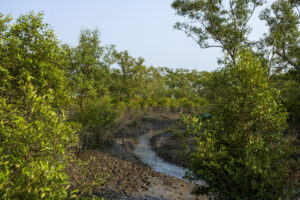About Sundarban

The Sundarban, the world’s largest mangrove forest, is a remarkable natural wonder spanning across Bangladesh and India. This unique ecosystem, characterized by its diverse flora and fauna, is home to the iconic Royal Bengal Tiger and numerous other endangered species. Serving as a crucial habitat for wildlife and a vital resource for local communities, the Sundarban’s exceptional beauty and ecological significance make it a must-visit destination for nature enthusiasts and those interested in learning more about Sundarban’s rich heritage.
What is Sundarban Famous For?
A Comprehensive Guide to the World’s Largest Mangrove Forest

Introduction to Sundarban: A Natural Wonder
The Sundarban, located in the delta region of the Ganges, Brahmaputra, and Meghna rivers, is a remarkable natural wonder. This vast mangrove forest, spanning across Bangladesh and India, is the largest of its kind in the world. Known for its rich biodiversity, the Sundarban is home to numerous species of plants, animals, and marine life, making it an ecological hotspot and an essential part of our planet’s natural heritage.
The Royal Bengal Tiger: Sundarban’s Iconic Inhabitant
One of the most famous inhabitants of the Sundarban is the majestic Royal Bengal Tiger. This iconic species has long been a symbol of strength and beauty in the region, drawing wildlife enthusiasts and tourists from around the globe. The Sundarban serves as a critical habitat for these tigers, providing a safe haven where they can thrive away from human interference. With their unique ability to navigate and swim through the mangrove’s complex waterways, the Royal Bengal Tiger has adapted to the challenging environment of the Sundarban, making it a truly remarkable animal.
About Sundarban Biodiversity: A Haven for Flora and Fauna
Aside from the Royal Bengal Tiger, the Sundarban is also home to a diverse array of plant and animal species. As a UNESCO World Heritage Site, the Sundarban is recognized for its outstanding universal value, particularly its role as a sanctuary for many endangered species. The mangrove forest is home to several rare animals, such as the Irrawaddy dolphin, estuarine crocodile, and Indian python. Additionally, over 200 species of birds, including the endangered masked finfoot and the black-capped kingfisher, can be found in this unique ecosystem.
Plants in Sundarban
The Sundarban’s rich flora is equally impressive. With over 84 species of mangroves, the forest serves as a vital resource for maintaining the region’s ecological balance. These mangroves play a crucial role in protecting coastal areas from erosion, storm surges, and tsunamis, highlighting the importance of preserving this unique ecosystem.
Sundarban’s Unique Culture and Heritage
The Sundarban region is not only renowned for its natural beauty but also for its vibrant culture and heritage. The local communities, comprised of fishermen, honey collectors, and woodcutters, have lived in harmony with the forest for generations. Their sustainable practices and traditional knowledge have shaped the Sundarban’s unique cultural landscape, adding to the region’s allure.
During Sundarban travel, you can experience this rich heritage through various cultural events and festivals, such as the Rash Mela, a colorful celebration of the Hindu god Krishna. Folk songs and dances, like the Jhumur and Baul, also provide a glimpse into the area’s artistic traditions, reflecting the region’s deep connection to its natural surroundings.
Sundarban Tourism: Exploring the Sundarban Responsibly
Tourism in the Sundarban has grown in recent years, with visitors eager to explore the pristine beauty of this unique landscape. As a result, sustainable Sundarban tourism practices have become increasingly important to protect the delicate ecosystem and support local communities. Several ecotourism initiatives, such as guided boat tours and community-led homestays, offer an authentic and environmentally responsible way to experience the Sundarban. By promoting responsible Sundarban tourism, visitors can help preserve this natural wonder for future generations.
Conservation Efforts: Safeguarding the Sundarban
Given the Sundarban’s global significance, numerous conservation efforts have been undertaken to protect this unique ecosystem. The forest is part of the Sundarbans Reserve
Forest, which spans both Bangladesh and India, and is managed by their respective governments. This joint management is essential in preserving the delicate balance of the Sundarban’s diverse flora and fauna.
International organizations, such as UNESCO and the Ramsar Convention on Wetlands, have also recognized the Sundarban’s importance and have implemented various conservation initiatives to safeguard its integrity. Community-based conservation programs have proven particularly effective, as they involve local residents in preserving the forest and its resources. These efforts include reforestation projects, sustainable livelihood initiatives, and educational campaigns to raise awareness about the Sundarban’s ecological significance.
Climate Change: The Sundarban’s Greatest Challenge
Climate change poses a significant threat to the Sundarban’s fragile ecosystem. Rising sea levels, increased salinity, and extreme weather events are all potential consequences of global warming, which could devastate the Sundarban’s rich biodiversity. To mitigate these impacts, proactive measures such as mangrove plantation projects and the construction of embankments have been implemented. Additionally, ongoing research and monitoring are crucial to understanding the impacts of climate change on the Sundarban and developing adaptive strategies to protect its valuable resources.
Conclusion: The Sundarban’s Enduring Legacy
In conclusion, the Sundarban is famous for its unparalleled natural beauty, diverse wildlife, and unique cultural heritage. As the world’s largest mangrove forest, it plays a vital role in maintaining our planet’s ecological balance and supporting the livelihoods of the local communities. By promoting sustainable tourism, implementing conservation efforts, and addressing the challenges posed by climate change, we can ensure that the Sundarban’s legacy endures for generations to come.